Keywords: -Prosumption -Customisation -Brick and Mortar -Architectural -Captabases -Spacial Fetishism -Interdependendencies Definition: Customisation is the allowance to personalize a product for a single individual creating a unique object. Customisation always existed but only for wealthy… Altro
Gender, Body Image.
This blog post will focus on females and how they are portrayed by society. In other words, how the perception of beauty has been changed focusing on body image. The weight obsession is an issue that will always exist. It is interesting to notice that advertising has the power to transform what is the perception of beauty and sometimes it makes a woman feel unsatisfied with herself. In the past decades the problem was about being too lean whilst in our days there is the fear of gaining weight.
“Men wouldn’t look at me when I was skinny.” (Toya,2011). Image 1 is a vintage advert that presents a joyful woman with curves proud of her having gained mass. The lady sees a positive change in her body and she seems thankful for it since she claims that she can have what ever man she desires. But what if a lady was naturally skinny? Looking at the adverts of the past decades, being thin wouldn’t have permitted a woman to be accompanied by man and this is a result of not being accepted and appreciated by society. This claim is strengthened by looking at Image 2 where there is a skinny figure admiring a lady with curves and advertising a product Natural Mineral Concentrate that would have gave the possibility to skinny girls of gaining weight. How beauty is seen in terms of physical appearance is completely shaped by society and especially advertising. This may lead to great psychological issues where a woman will never feel enough and will never appreciate her natural gifts.
“What gives Victoria’s Secret the right to say what a “perfect” body is?? Stop body shaming!!”(Freda, 2014). The comment above was done against the campaign shown in Image 3. The advert presents ten skinny models posing for a very famous company which day by day seem to damage a woman’s self esteem (Freda, 2014). Why does a company so famous such as Victoria Secret present a problem of body shaming instead of raising it’s awareness? Unfortunately woman because of advertisements are really insecure of themselves this is because they buy products which are presented on skinny people thinking that it will have the same effect but the result is “All this does is perpetuate low self-esteem among women who are made to feel that their bodies are inadequate and unattractive because they do not fit into a narrow standard of beauty. It contributes to a culture that encourages serious health problems such as negative body image and eating disorders.” (Bahadur, 2014). Advertisements are showing society that in order to be perfect you have to be skinny, have long legs, flat stomach and visible body bones. Men tend to admire much more skinny girls and especially models, ignoring women with curves that once were the more venerated.
The adverts that have been done in the past decades and in our days are really offensive towards woman. They do not accept natural bodies as it is shown but especially, no matter how you look like you will need to change in order to be accepted by society and looked in the way a woman wants to be looked by men.
Image one
Source : http://thelimericklane.com/2011/11/vintage-ad-men-wouldnt-look-at-me-when-i-was-skinny/
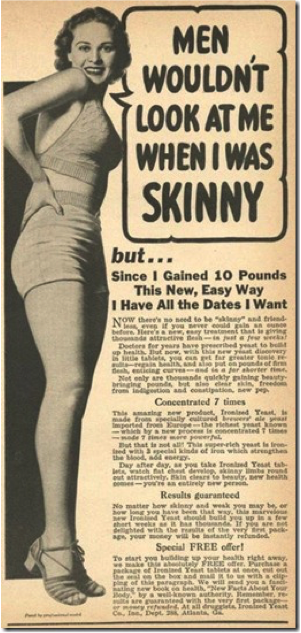
Image two
Source : http://thewvsr.com/naturallyskinny.htm
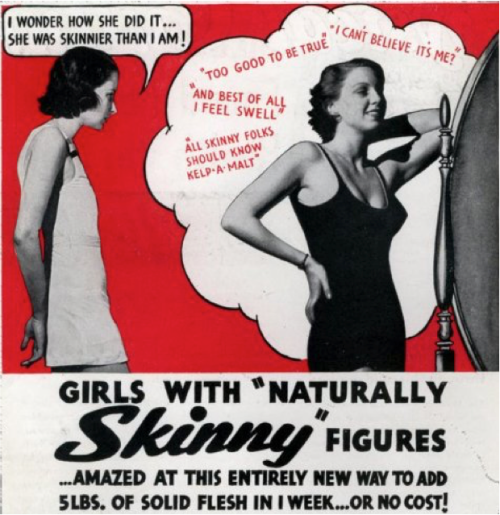
Image three
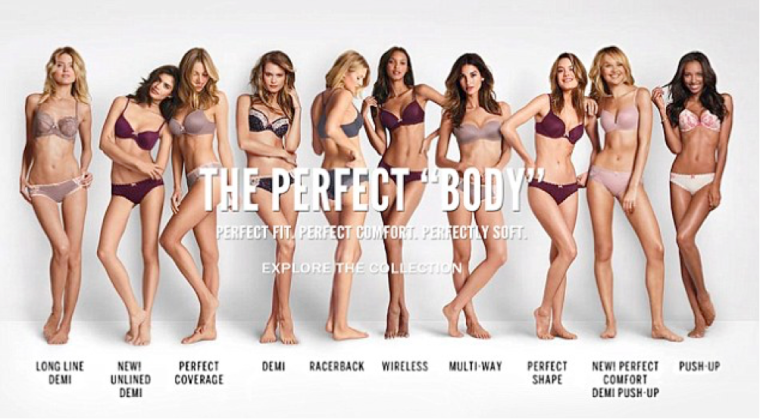
References:
Bahadur, N. (2014). Victoria’s Secret ‘Perfect Body’ Campaign Changes Slogan After Backlash. HUFFPOST WOMEN, 11 June. Available from: http://www.huffingtonpost.com/2014/11/06/victorias-secret-perfect-body-campaign_n_6115728.html [Accessed 2 April 2016].
Freda, E. (2014).Victoria’s Secret “Perfect ‘Body'” Ad Campaign Sparks Outrage Online. E!. Available from: http://www.eonline.com/news/593050/victoria-s-secret-perfect-body-ad-campaign-sparks-outrage-online [Accessed 1 April 2016].
Toya (2011). Vintage Ad: “Men Wouldn’t Look At Me When I Was Skinny”. The Limerick Lane. Available from: http://thelimericklane.com/2011/11/vintage-ad-men-wouldnt-look-at-me-when-i-was-skinny/ [Accessed 1 April 2016].
Race, the big issue
Did the discrimination of race change in the advertising industry? This discussion looks at how during the period of ‘High Imperialism’ there was a notable racial difference between the European powers for the control of Africa whilst in our days it seems to be as if new messages have been sent through out campaigns in order to break down this ideal of inferiority within races.
In the 19th century, the images shown of black people in advertising were only associations of them being portrayed as slaves (Graca da Silva, 2012).Their inferiority was shown majorly when talking about hygiene where it was stated that “white was associated wit light cleanliness and purity, whilst black evokes darkness, dirt and evil.”(Bolaffi, 2003). The faces of black people appeared to show the difference in contrast of skin color from black to white. This is clearly shown in Pears Soap advertisement. According to Image one, it is clear to notice that the white boy is assuming a posture of superiority towards the black boy as if he is teaching that through Pierce he will learn how to become white and pure. This reinforces the idea that being black was “negative” (BBC News, N.D.). Moreover the calm expression of the white boy suggests that “he is elegant and of a higher class” (Visual Culture Blog, 2016) unlike the black boy that has a smile on his face. The discrimination towards black people was a big issue, individuals did not have rights and were never considered. Luckily things started to change.
Thanks to the brand Benetton, Oliviero Toscani wanted to spread awareness by introducing a “new language” (Gentili, 2015). This would have changed the perception of society talking about race, starting by the fact that the brand would have been spread internationally and be seen as United. The promotional campaigns would have touched delicate themes such as race. In fact, Luciano Benetton explained that their purpose through advertising was: “we did not create our advertisements in order to provoke, but to make people talk, to develop citizen consciousness,” (Blickwink, 2012). This is clearly shown in image 2, with an advert from 1991 which gives a powerful message to the audience about unity. The image is showing three different races under a single blanket which symbolizes union and gives a sense of reassurance and family. This advert has a powerful impact to the audience as the difference in skin color is combined through the gesture of the elders having their hands clasped together. The black arm is over the white one. This may be interpreted as a symbol of purity and mutuality between races. Everyone is portrayed as being the same, under the same sheet and holding tightly together.
The idea of superiority and inferiority seems to be changing and thanks to advertising the messages that adverts are sending are really powerful. There have been notable changes from the 19th century to the 21st where the advertising industry is managing to change the perception of society into a unite world.
Image one
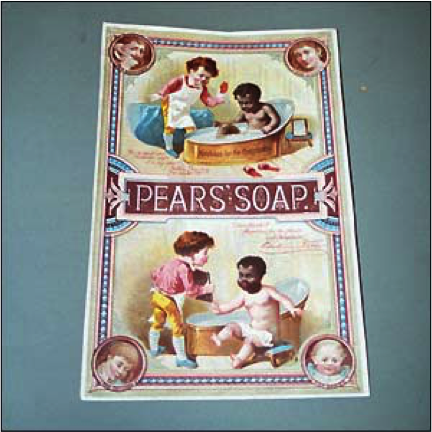
Image two
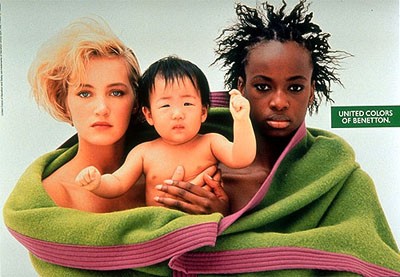
References:
BBC News (N.D.). Black Representation in Advertising. BBC News. Available from: http://news.bbc.co.uk/2/shared/spl/hi/pop_ups/02/uk_black_representation_in_advertising/html/3.stm [Accessed 3 April 2016].
Blickwink (2012). 10 Most Controversial United Colors of Benetton Ads. Alistgator. Available from: http://www.alistgator.com/top-ten-controversial-united-colors-of-benetton-ads/ [Accessed 4 April 2016].
Bolaffi, G. (2003). Dictionary of Race, Ethnicity and Culture. London: SAGE Publications.
Gentili, A. (2015). “Behind” the Colors of Benetton: the reasons of Benetton’s controversial success. Riflessi Storici. Available from: https://riflessistorici.com/2015/09/01/behind-the-colors-of-benetton-the-reasons-of-benettons-controversial-success/ [Accessed 4 April 2016].
Graca da Silva, S. (2012). (Dis)Entangling Darwin: Cross-disciplinary Reflections on the Man and His Legacy. Cambridge: Scholar Publishing.
Visual Culture Blog (2015). Pears’ Soap Advertisement Analysis. Visual Culture Blog. Available from: https://thefutureisvisual.wordpress.com/2014/03/26/pears-soap-advertisement-analysis/ [Accessed 4 April 2016].
Conspicuous Consumption
Through advertising consumers seem to buy expensive and luxurious products just to show their wealth instead of what their real necessities are. This act is called Conspicuous Consumption. People tend to buy products just depending upon high perception of brand image rather than having an item that satisfies the needs of the consumer. “Thorstein Veblen coined the term conspicuous consumption in 1899 to describe spending with the intention of gaining social status” (Ordabayeva and Chandon, 2012).
Image 1 is an advert that portrays a provocative woman used to represent the luxurious car brand ‘Aston Martin.’ The product itself is not shown but since the target audience seem to be male, the brand decided to put a desirable woman in order to attract the public and show what they will be able to possess once they buy the car. This is an example of conspicuous consumption since it is telling the consumer that if they buy the product they will have the one thing that a man desires which is showing wealth through luxurious brands even if it will result in a huge loss of money. What if you do not have the luxury products, would you be nullity? Berger, J developed this point claiming that “‘If you are able to buy this product you will be loveable. If you cannot buy it, you will be less loveable.” (Berger, 1972). Through the act of conspicuous consumption it seems as if it is all a matter of appearing that will result in a battle between the great loss of money by purchasing an Aston Martin but on the other hand the brand image is so powerful that if you buy the product you will be able to obtain the fame that in this case will give you a provocative woman.
Back in the 18th century, what symbolised social status was for example silver, gold and expensive clothes, which still seem to be very admired in our days. Image two in fact is an advert of 1766 which was selling items that were aimed at wealthy families in those times for example horses. The items that were advertised in Image 2 don’t appeal to just one market which is the wealthy class but it also looks at the general public. This is shown clearly when the vendor includes items such as “gloves, blankets, buttons” to give possibility through conspicuous consumption to permit lower classes to be satisfied. This has been done in order to make people feel equal, alleviating what can be called as a “psychological pain.” (Tutle, 2010).
To conclude, conspicuous consumption seems to be a topic for which many individuals are affected by. Adverts influence consumers to enhance equality and invest more that will result in giving them benefit and gain a higher social status. But in the end, “it proposes to each of us that we transform ourselves, or our lives by buying something more…it will make us in some way richer — even though we will be poorer by having spent our money.” (Berger, 1972)
Image one
Source : http://a-white1215-dc.blogspot.it/2013_10_01_archive.html

Image two
Source : https://adverts250project.org/tag/conspicuous-consumption/
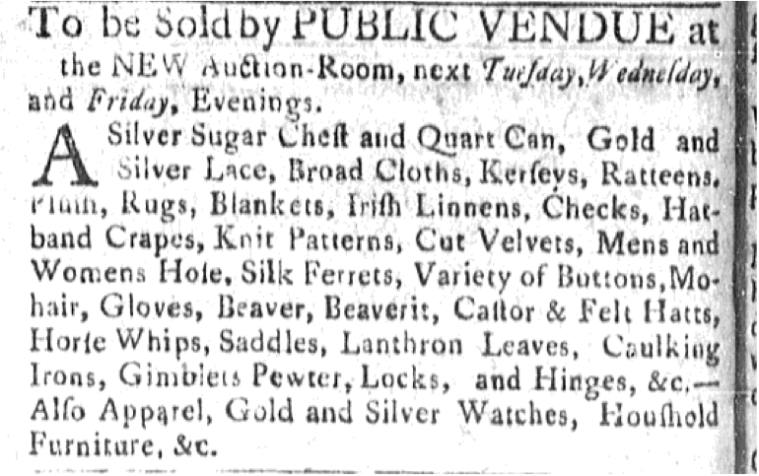
References:
Berger, J. (1972). Ways of Seeing. London: BBC and Penguin Books Ltd.
Ordabayeva, N. and Chandon, P. (2012). When Spending Hurts. The European Business Review, 22 July. Available from: http://www.europeanbusinessreview.com/?p=2578 [Accessed 5 April 2016].
Tutle, B. (2010). Psych Study: When You’re Bummed, You’re More Likely to Buy. Time, 7 May. Available from: http://business.time.com/2010/05/07/study-low-self-esteem-makes-you-more-likely-to-buy-luxury-goods/ [Accessed 5 April 2016].





